In 1972, the then-named University of Nevada, Reno School of Medical Sciences faculty collaborated with the Grand Chapter Royal Arch Masons of Nevada to set a cornerstone and place a time capsule in the walls of the Anderson Health Sciences building. At the ceremony on April 8, 1972, the medical school’s first class president, Dr. George Manning, ’73 M.D., gave a speech at the request of dean Dr. George T. Smith.
Almost 50 years later, as the class of 1973 began planning its reunion, Dr. Manning suggested opening it, much to the surprise of existing staff and faculty. But he did not know what the faculty put inside the capsule all those years ago.
On Wednesday, May 10, 2023, the University’s School of Medicine (UNR Med) Dean Dr. Paul J. Hauptman and Dr. Manning removed the time capsule, and Dr. Manning opened its contents in front of about 20 of his fellow graduates and their families, as part of their 50th class reunion. University and NSHE leadership and other observers watched as Dr. Manning pulled more than 50 items from the large copper box, including pamphlets, legislative bills, letters, articles, newspapers, resumes, and photographs from the era, coins, a Vase of Gilgamesh, and Native American herbal medicines. (For a complete list of items, see below.)
Before Dr. Manning opened the time capsule, University President Brian Sandoval and Dean Hauptman addressed the faculty, staff, students, and graduates who gathered to see its contents revealed.
“Medicine has changed a lot in the last 50 years, and it will change a lot in the next 50, but two true-isms have not and will not change,” Dr. Hauptman said. “The primacy of the patient and the desire of our medical students, both the Class of 1973 and the Class of 2023, to provide medical care and relief from pain and suffering.”
Dr. Hauptman described the many milestones of 1973, including the end of U.S. involvement in Vietnam, the American Psychiatric Association removing “mental disorder” from the definition of homosexuality, and “The Godfather” winning Best Picture at the Academy Awards.
“It’s an honor and privilege to be part of this ceremony, and I am humbled to be here and in your presence,” President Sandoval said. “I see how many lives you changed and counseled and the difference you made no matter where you went. From the bottom of my heart and the University of Nevada, I want to thank you for your commitment.”
The first 32 medical students
Established in 1969 as the first medical school in Nevada, Dr. Manning said that UNR Med was born out of a need for physicians to fill much-needed gaps in healthcare coverage and train more doctors to practice throughout the state. Its first class of 32 medical students came to the University for the two-year medical school program covering basic science and pre-clinical education. They then transferred to four-year medical schools to complete their training.
“When this school opened, and I was accepted, it was one of the most exciting days in my life,” Dr. Manning said. “And there were 31 people who felt the same as me.”
Several of Dr. Manning’s classmates attended the event, and many spoke of the deep camaraderie of their class. Retired Dr. Jim Moren, ’73 M.D., said the faculty and students worked 40 hours per week together learning, practicing in clinics, and reading because everyone wanted the school to succeed and grow.
“We were all in it together,” Dr. Moren said.
That approach taught them to build on each other’s successes. Retired Dr. Mary Turner, ’73 M.D., remembered attending her second medical school and finding that students competed instead of building each other up. She and other class of 1973 graduates said they loved their Reno experience and think of it fondly because it turned them into more cooperative and compassionate doctors.
“The medical school taught me to treat patients as people and not just what was wrong with them,” Dr. Turner said. “That helped me pay attention to what they said or how I approached them or how likely they were to follow through on the care we discussed.” Traditionally two-year schools focused on academic study and anatomy, but the 14 original faculty members approached the new program differently. Turner remembers learning with cadavers, visiting physicians, and focusing on behavioral health and bedside manners. “We didn’t have the bells and whistles of big schools, but when we got to our four-year schools, we were well prepared,” Dr. Moren said.
Drs. Turner and Moren went on to become family doctors. Dr. Turner helped lead a centralized clinic program in Edmonton, Alberta, Canada, that focused on creating faster referral and screening systems to improve patient medical outcomes. Dr. Manning served as a U.S. Army doctor for 25 years before moving to a small town in Texas to fulfill the medical school’s mission of providing care in underserved communities.
“We are inspired by their legacy of commitment to progress,” Robert Gullickson (MS-4), the current UNR Med class vice president said about the 1973 graduates.
For the next 50 years of medicine
At the time capsule’s reveal, Gullickson announced the class of 2023 would replace the 1973 time capsule with a new one. Inside, the students placed mementos and messages to capture their experience, including an N95 mask, COVID-19 vaccine cards, ping pong balls, pictures, and a hard drive containing more documentation and photographs from this year.
“It's incredibly exciting to have the opportunity to memorialize these classes with time capsules, leaving a lasting legacy for future students,” said Laurice Antoun-Becker, Senior Director of Development for UNR Med.
Another way to create an enduring legacy is through endowments and scholarships, she said. An endowment from the class of ’73 was created for future students, and Antoun-Becker is encouraging donations of $1,973. Once the school deposits the minimum investment value to create an endowment, it is invested and grows yearly to award students in perpetuity.
“A time capsule is just one avenue among many to create a treasure trove for the future,” Antoun-Becker said. “An endowment allows every graduating class to expand their impact far beyond their time at UNR Med and positively shape the lives of countless students for years to come.”
Dr. Manning agreed that every graduating doctor should leave a legacy that supports the following generation. “One of the big anxieties we had as students was wondering where the next dollar was coming from to fund the school,” Dr. Manning said. “I don’t know how in the world we could ever repay what the school did for us. But, we should ask, ‘What can we do to make life better in Nevada and the United States or my little town?’”
History Revealed
From historical records and Masonic affiliations to medical education proposals and Native American herbal remedies of the time, the time capsule’s more than 50 items offer a glimpse into the tapestry of the University’s history, the aspirations of the burgeoning medical school program, the contributions made by individuals and organizations, and their commitment to advancing healthcare and knowledge in the region.
Items will be given to the Savitt Medical Library for proper restoration, archiving and display. Select items were placed back into the time capsule to be revealed in 2073, spanning a full hundred years.
- A gold cross inlaid with red enamel
- A Medical Emblem of the Medic Alert Foundation International, donated by Barbara Savoy
- Seeds of the Great Plane Tree from the Isle of Cos, a symbol of growth and longevity
- Six vials of Native American herbal medicines, each containing a different plant species, including Ephedra nevadensis (Mormon tea), Rumex venosus (wild-begonia), Leptotaenia multifida Nutt. (giant biscuitroot), Veratrum californicum (California corn lily), Nicotiana attenuata (coyote tobacco), and Larrea divaricata (chaparral)
- A silver Torch of Learning And Knowledge
- A reproduction of the Vase of Gilgamesh, dating back to 2100 B.C., representing the historical and cultural significance of medicine and healing practices
- Coins from 1971, including a half dollar, quarter, dime, nickel, and penny
- An Eisenhower dollar coin from 1971, donated by Eleanor Dalton
- An 1878 Carson City Silver Dollar
- A document chronicling the Cornerstone Ceremony held on April 8, 1972
- The written remarks delivered by William A. O’Brien III, M.D., during the Cornerstone Ceremony
- An invitation to the Cornerstone Ceremony, jointly sent by the Medical School and the College of Agriculture
- A program outlining the details of the Cornerstone Placing ceremony
- A list of class officers and students enrolled in the Medical School for the academic year 1971-72
- An estimated budget covering fiscal years 1971 through 1974
- A document titled “Health Science Program UNR 1971”
- A photograph from 1971 depicting the columns of the Mackay Science Hall, which served as the first classroom building for medical students
- A photograph capturing the groundbreaking ceremony of the Anderson Health Science Building in May 1971
- A ten-year plan outlining the goals and objectives for the College of Agriculture from 1970 to 1980
- A proposal titled “Medical Education: Proposal for Interstate Planning and Programming,” dated March 26, 1968, authored by Ward Darley
- An article titled “Medical Practice in the Next Decade,” authored by Dr. Anderson in 1965
- Agreement between the University and architect Edward S. Parsons, A.I.A.
- A contract between the University of Nevada and the Johnson & Mape Construction Co. specifying a construction cost of $624,500.
- A floor plan of the health science facilities
- Photos and biographical information of the health science faculty
- A photograph of Dr. Anderson, a member and chairman of the Board of Regents, an active figure in University affairs and instrumental in the founding and development of UNR Med
- A copy of Assembly Bill 130, dated Jan. 30, 1969, authorizing and appropriating expenditures for the Health Science program
- Comments made before the Nevada State Legislature on Feb. 10, 1969, by various individuals, including Chancellor N. D. Humphrey, University President N. Edd Miller, Dean George T. Smith, Dean Harold L. Kirkpatrick, and Chairman of the Board of Regents Dr. Fred M. Anderson
- A photograph capturing Governor Laxalt signing a bill authorizing the establishment of a Medical School in 1969
- Agreement with Howard R. Hughes, May 31, 1968, and Supplemental Agreement, Dec. 30, 1968, documenting his critical pledge of $6 million that ultimately led to the state assembly passing the bill establishing the medical school
- The appendix to the 1968 University of Nevada Medical Education Feasibility Study
- A feasibility study conducted in November 1968 by the University on medical education
- A copy of Assembly Concurrent Resolution No. 15, passed on March 17, 1967, encouraging the Board of Regents to continue the feasibility study of a medical school
- A copy of a letter dated Oct. 2, 1967, from H. Edward Manville, Jr., Trustee, to the Morgan Guaranty Trust Co. in New York, predesignating a $1 million trust
- A copy of the University’s student newspaper, The Nevada Sagebrush, dated April 4, 1972
- A copy of the alumni news publication, Volume 10, No. 1, from March 1972
- An editorial article from the Nevada State Journal dated Feb. 26, 1972
- An article from the Reno Evening Gazette dated Feb. 24, 1972
- A copy of the Nevada Ranch & Home Review from Spring-Summer 1971
- Notes and tips relating to the Health Science Unit #1, dated July 1971
- A series of “Health News” publications from July 1970, January 1971, September 1971, December 1971, and March 1972
- A document titled “Medical Education Philosophy and Objectives,” dated Jan. 13, 1970
- A publication discussing news medical education from November 1970
- A booklet titled “Life and Health Sciences Library”
- A publication titled “Medical Education for Sparsely Settled States” from the Western Interstate Commission for Higher Education (WICHE)
- A document discussing a two-year medical school program focused on health science
- A book titled “Political History of Nevada,” dated 1965
- An article titled “A Cornerstone for the Capitol” from June 8, 1870
- A historical account detailing the construction and history of the Nevada Capitol Building and Governor’s Mansion
- A list of Masonic officers for the year 1971-72 featuring various Masonic bodies such as the Grand Lodge F. & A.M., Grand Chapter Royal Arch Masons, Grand Council Royal and Select Masters, Grand Commandery Knights Templar, Ancient & Accepted Scottish Rite of Freemasonry of Nevada, Ancient & Accepted Scottish Rite of Freemasonry of Las Vegas and Kerak Temple A.A.O.N.M.S.
- Proceedings from several Masonic bodies in Nevada documenting the activities and discussions of the Grand Lodge Free & Accepted Masons in 1971, Grand Chapter Royal Arch Masons in 1970, the Grand Council Royal and Select Masters in 1970, and Grand Commandery Knights Templar in 1971
- A list of 203 cornerstones laid between July 5, 1866, and April 8, 1972















